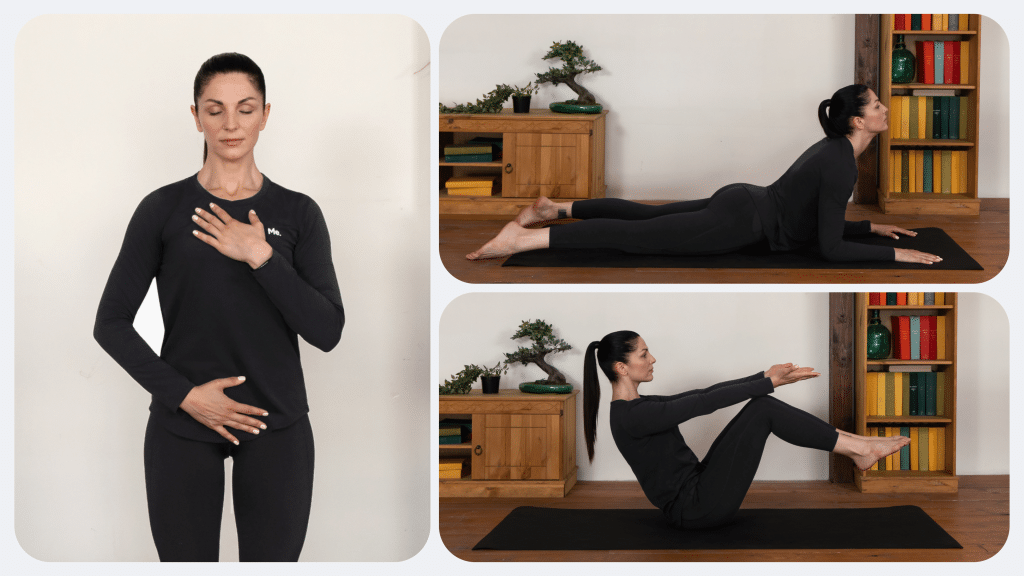Imagine a world in which healing isn’t confined to your mind, but embraces the very essence of your body. Welcome to the transformative realm of somatic healing exercises—a powerful practice that taps into your body’s innate ability to heal, releasing stress, unresolved emotions, and tension.
The term “somatic” is derived from the Greek word “soma”, which means “body”, and highlights the importance of the physical self in the healing process (1). Unlike traditional approaches that often take a top-down perspective, focusing on the mind’s influence over the body, somatic healing utilizes a bottom-up approach and recognizes the profound impact the body has on the mind and emotions.
Developed by pioneers in the field including Dr. Peter Levine and Dr. David Berceli, somatic healing exercises have gained increasing popularity as an effective way to address both physical and emotional well-being. Dr. Levine is the creator of somatic experiencing (SE), a therapy focused on restoring the body’s natural ability to self-regulate and heal by gently guiding individuals to experience and process their physical sensations (2).
Dr. Berceli developed tension and trauma releasing exercises (TRE), which help release deep muscular patterns of stress and trauma by inducing therapeutic tremors in the body (3). These practices are rooted in the understanding that trauma and stress are stored in the mind and embedded in the body’s tissues, muscles, and nervous system.
What Is Somatic Healing?
Somatic healing exercises are a holistic approach that emphasizes the body’s sensations to release and resolve trapped emotions, thereby promoting healing and enhancing mental and physical well-being (4). Contrary to traditional therapies that are primarily focused on the mind, somatic healing adopts a more integrated approach. It emphasizes body awareness, movement, and touch as key components of the healing process. This method helps you reconnect with your body and address the physical manifestations of emotions.
By paying close attention to bodily sensations, you can uncover and release emotions that have been stored due to traumatic events or stressful situations. The process of reconnecting with the body and releasing these emotions can result in significant improvements to your mental and physical well-being. Somatic healing exercises aim to alleviate psychological distress and promote physical vitality by addressing the root causes of tension and discomfort in the body.
How to Begin Somatic Healing
Finding the right somatic healing exercise or therapy is dependent on your specific goals and needs. Some somatic exercises can easily be tried at home with minimal equipment—all you need is a quiet space and some dedicated time. Whether you’re seeking to address specific emotions, alleviate stress, or simply enhance your overall well-being, there’s likely a somatic practice that suits your requirements.
Here are a few simple steps to start your journey in somatic healing exercises:
- Choose a Practice That Suits Your Needs: Select a somatic exercise that is in alignment with your goals. For example, to alleviate stress, try deep breathing exercises, or if you want to enhance body awareness, consider body scanning or gentle stretching.
- Find a Quiet and Calm Space: Choose a comfortable and quiet place where you can focus without any interruption.
- Wear comfortable clothing: Dress in loose, comfortable clothing that allows you to move freely and focus on your body’s sensations without any distraction.
- Be Open-Minded and Non-Judgmental: Approach the exercises with an open mind and avoid judging your experiences or bodily sensations. Allow yourself to fully engage with any sensations and emotions that arise.
- Seek Further Guidance: Consider working with a certified somatic therapist or using an app or online resource that offers guided somatic exercises. Professional guidance can help deepen your practice and make sure you perform the exercises correctly.
By following these steps, you can start to explore the benefits of somatic healing and find the practices that work best for you.
BetterMe will shake off your mental funk, rid you of your energy-zapping habits, and help you sculpt the body of your dreams. Intrigued? Hurry up and change your life for the better!
What Is an Example of a Somatic Healing Practice?
One common somatic healing practice is a body scan. This is a simple yet powerful exercise. Here’s a step-by-step guide to performing a body scan exercise:
- Find a Comfortable Position: Lie down on your back or sit in a comfortable chair. Close your eyes or maintain a soft gaze. Take a few deep breaths to relax.
- Start at the Toes: Start by focusing on your toes. Notice any sensations, tension, or areas of relaxation without judgment.
- Move Up Slowly: Gradually shift your attention up your body, moving through your feet, ankles, calves, knees, and thighs. Spend a few moments on each area, observing any sensations or emotions that arise, without judging them.
- Continue to the Torso: Scan your hips, abdomen, lower back, upper back, and chest. Notice how each part of your body feels without attempting to change anything.
- Focus on the Limbs: Shift your attention to your fingers, hands, arms, and shoulders. Pay attention to any areas of tension or discomfort.
- End at the Head: Finish the scan by focusing on your neck, jaw, face, and the top of your head. Take a moment to feel the connection between your body and the ground or surface you are lying on.
- Take a Few Final Breaths: After scanning your entire body, take a few deep breaths and slowly open your eyes.
Body scanning provides numerous benefits, including increased body awareness, which helps you become more attuned to your body’s sensations and where you might be holding tension or stress. This practice promotes deep relaxation, reduces stress, and enhances the mind-body connection (5, 6, 7) By becoming more aware of bodily sensations, you can improve emotional regulation (8), which leads to a more centered and peaceful state of being.
Read more: Somatic Bedtime Routine: How it Helps and What it Looks Like
Somatic Healing Exercises vs. Reiki
While somatic healing exercises and reiki both aim to promote holistic well-being, they differ in terms of approach:
- Somatic Healing Exercises: These involve active participation through movement, breathwork, and body awareness techniques. The focus is on experiencing and releasing sensations and emotions stored in the body.
- Reiki: Reiki is a form of energy healing that involves a practitioner channeling energy into the recipient’s body to promote balance and healing. The recipient remains passive, receiving the energy through light touch or hovering hands.
What Somatic Exercises Release Trauma in the Body?
Certain somatic exercises are particularly effective for releasing trauma:
- Tension and Trauma Releasing Exercises (TRE): Developed by Dr. David Berceli, TRE involves a series of exercises that helps release deep muscular patterns of stress and trauma by inducing therapeutic tremors in the body (9, 10). TRE should be guided by a trained therapist to ensure safety and effectiveness.
- Somatic Experiencing (SE): SE was created by Dr. Peter Levine and focuses on restoring the body’s natural ability to self-regulate and heal by gently guiding you to experience and process your physical sensations (11, 12). SE sessions are typically conducted by a trained therapist who helps facilitate the healing process.
- Grounding Exercises: Techniques such as mindful walking, grounding your feet, and focusing on the connection between your body and the earth can help you manage signs of stress, fear, and other responses that are linked to traumatic events, bringing you back to the present moment. These exercises can be practiced at home and integrated into daily routines as a means of supporting ongoing healing and well-being.
Read more: 6 Somatic Workouts for Women
How Often Should You Do Somatic Exercises to Heal?
The frequency of somatic exercises can vary depending on your needs and goals. Practicing somatic exercises a few times a week can be beneficial for your general well-being. However, if you find yourself dealing with stress, daily practice may be more effective for supporting your healing journey. It’s important to listen to your body and not push beyond your comfort level.
BetterMe: Health Coaching app helps you achieve your body goals with ease and efficiency by helping to choose proper meal plans and effective workouts. Start using our app and you will see good results in a short time.
Incorporating grounding exercises, such as mindful walking or focusing on the sensation of your feet on the ground, together with breathing techniques, into your daily routine can be particularly useful. These practices can help regulate emotions and promote a sense of calm and stability throughout your day.
If you’re looking to manage trauma or deeper emotional issues, it’s advisable to reach out to a trained therapist. A therapist may recommend modalities such as somatic experiencing (SE) or tension and trauma releasing exercises (TRE) that are tailored to your specific needs. SE and TRE are typically guided by trained professionals who provide support and guidance as you navigate through the healing process.
By integrating somatic exercises into your routine, either through daily practices at home or sessions with a therapist, you can effectively support your body’s natural healing mechanisms and promote overall mental and physical well-being.
Trauma can be stored in various parts of the body, particularly in muscles, tissues, and the nervous system (12, 13). It often manifests as tension, pain, or other physical symptoms. Yes, somatic exercises can support the release of unresolved emotions by allowing your body to process these stored sensations and emotions. Walking is generally not considered a somatic exercise, but it can be if it is done mindfully. Paying attention to your breath, the sensations in your feet, and the movement of your body can make walking a powerful somatic practice. While traditional yoga offers numerous physical and mental benefits, it’s not universally categorized as somatic healing. However, styles such as Hatha and Yin yoga emphasize body awareness, breathwork, and the mindful connection between body and mind, which aligns closely with somatic principles. In addition, somatic yoga blends somatic psychology with yoga practices, focusing on body awareness, relaxation, and releasing tension. Somatic healing exercises offer a gentle yet powerful way to reconnect with your body, release stored emotions, and enhance overall well-being. Whether you’re new to this practice or are looking to deepen your existing routine, somatic exercises can be a valuable addition to your wellness journey. Incorporating techniques such as grounding exercises, mindful movement, and breathwork can help you create a deeper connection with your body and manage stress more effectively. If you’re looking to manage trauma or address deeper emotional issues, it’s recommended that you seek guidance from a trained therapist. Therapies such as somatic experiencing (SE) and tension and trauma releasing exercises (TRE) are specifically designed to help process and release trauma that is stored in the body. A qualified therapist can provide personalized support and guidance that is tailored to your unique needs, which will ensure a safe and effective healing process. By integrating somatic exercises and seeking professional guidance where necessary, you can improve your resilience, promote self-awareness, and embark on a journey toward holistic well-being.Frequently Asked Questions
Where is trauma stored in the body?
Do somatic exercises release trauma?
Is walking a somatic exercise?
Is yoga somatic healing?
DISCLAIMER:
This article is intended for general informational purposes only and does not serve to address individual circumstances. It is not a substitute for professional advice or help and should not be relied on for making any kind of decision-making. Any action taken as a direct or indirect result of the information in this article is entirely at your own risk and is your sole responsibility.
BetterMe, its content staff, and its medical advisors accept no responsibility for inaccuracies, errors, misstatements, inconsistencies, or omissions and specifically disclaim any liability, loss or risk, personal, professional or otherwise, which may be incurred as a consequence, directly or indirectly, of the use and/or application of any content.
You should always seek the advice of your physician or other qualified health provider with any questions you may have regarding a medical condition or your specific situation. Never disregard professional medical advice or delay seeking it because of BetterMe content. If you suspect or think you may have a medical emergency, call your doctor.
SOURCES:
- Somatic Psychology: Body, Mind and Meaning (n.d., books.google.lk)
- Somatic experiencing – effectiveness and key factors of a body-oriented trauma therapy: a scoping literature review (2021, tandfonline.com)
- The Effect of Tension and Trauma Releasing Exercises (TRE) on Trauma Symptoms in East African Refugees (2024, scirp.org)
- Effects of an 8-Week Body Scan Intervention on Individually Perceived Psychological Stress and Related Steroid Hormones in Hair (2019, link.springer.com)
- The effects of body scan meditation: A systematic review and meta-analysis (2022, iaap-journals.onlinelibrary.wiley.com)
- A Systematic Review of the Effects of the Body Scan on Stress and Psychopathology (2021, proquest.com)
- A Body Scan Meditation Reduces Negative Affect and Food Cravings in Emotional Eaters: A Randomized Controlled Study of the Effects, Mediators, and Moderators (2024, link.springer.com)
- Tension and trauma releasing exercises for people with multiple sclerosis – An exploratory pilot study (2021, sciencedirect.com)
- Trauma Releasing Exercises: A potential treatment for co-occurring post-traumatic stress disorder and non-specific chronic low back pain (2019, proquest.com)
- Somatic Experiencing for Posttraumatic Stress Disorder: A Randomized Controlled Outcome Study (2017, onlinelibrary.wiley.com)
- Effect of Somatic Experiencing Resiliency-Based Trauma Treatment Training on Quality of Life and Psychological Health as Potential Markers of Resilience in Treating Professionals (2018, frontiersin.org)
- Graduate Theorizations: Imaginative Applied Sociologies—Manifest and Latent (2011, books.google.lk)
- The Body Bears the Burden (2014, taylorfrancis.com)










